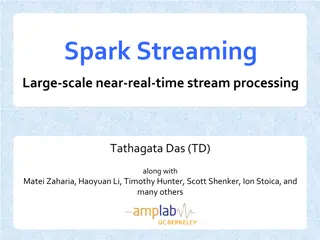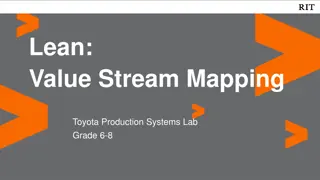
Exploring Advanced Data Mining Techniques and Challenges
Delve into advanced data mining topics such as infinite data streams, machine learning applications, data stream management, and more. Understand the importance of the data stream model, ad-hoc queries, and common operations on data streams in modern data mining scenarios.
Download Presentation

Please find below an Image/Link to download the presentation.
The content on the website is provided AS IS for your information and personal use only. It may not be sold, licensed, or shared on other websites without obtaining consent from the author. If you encounter any issues during the download, it is possible that the publisher has removed the file from their server.
You are allowed to download the files provided on this website for personal or commercial use, subject to the condition that they are used lawfully. All files are the property of their respective owners.
The content on the website is provided AS IS for your information and personal use only. It may not be sold, licensed, or shared on other websites without obtaining consent from the author.
E N D
Presentation Transcript
CAP5778 CAP5778 Advanced Data Mining Advanced Data Mining Data Streams Data Streams Peixiang Zhao Florida State university Part of the course materials are adapted or revised from Mining of Massive Datasets (mmds.org)
Infinite Data Infinite Data High dim. data Graph data Infinite data Machine learning Apps Locality sensitive hashing Filtering data streams PageRank, SimRank Recommen der systems SVM Network Analysis Web Decision Trees Association Rules Clustering advertising Dimensional ity reduction Duplicate document detection Spam Detection Queries on streams Perceptron, kNN 1
Data Streams Data Streams In many data mining situations, we do not know the entire data set in advance Stream Management is important when the input rate is controlled externally. For instance, Google queries Twitter or Facebook status updates We can think of the data as infinite and non-stationary (the distribution changes over time) 2
The Data Stream Model The Data Stream Model Input elements enter at a rapid rate, at one or more input ports (i.e., streams) The system cannot store the entire stream accessibly! Typically, one-scan, sketch-based solutions Research Question: How do you make critical calculations about the stream using a limited amount of (secondary) memory? 3
The Data Stream Model The Data Stream Model Ad-Hoc Queries Standing Queries . . . 1, 5, 2, 7, 0, 9, 3 . . . a, r, v, t, y, h, b Output Processor . . . 0, 0, 1, 0, 1, 1, 0 time Each stream is composed of elements/tuples Limited Working Storage Archival Storage 4
Problems on Data Streams Problems on Data Streams Types of operations one wants to perform on a data stream Filtering a data stream Select elements with property x x from the stream Counting distinct elements Number of distinct elements (in the last k k elements) of the stream Sampling data from a stream Construct a random sample Queries over sliding windows Number of items of type x x in the last k k elements of the stream 5
Applications Applications Mining query streams Google wants to know what queries are more frequent today than yesterday Mining click streams Amazon wants to know which of its pages are getting an unusual number of hits in the past hour Mining social network news feeds Looking for trending topics on Twitter, Facebook IP packets monitored at a switch Gather information for optimal routing Detect denial-of-service attacks 6
Filtering Data Streams: Definition Filtering Data Streams: Definition Each element of data stream is a tuple Given a list of keys S Determine which tuples of stream are in S Membership query: e S or not Baseline solution: Hash table But suppose we do not have enough memory to store all of S in a hash table E.g., we might be processing millions of filters on the same stream 7
Applications Applications Email spam filtering We know 1 billion good email addresses If an email comes from one of these, it is NOT spam Publish-subscribe systems You are collecting lots of messages (news articles) People express interest in certain sets of keywords Determine whether each message matches user s interest 8
First Cut Solution First Cut Solution Input: given a set of keys S that we want to filter Algorithm 1. Create a bit array B of n bits, initially all 0 s 2. Choose a hash function h with range [0,n) 3. Insertion: Hash each member of s S to one of n buckets, and set that bit to 1: B[ B[h h( (s s)]=1 )]=1 4. (Online step) Hash each element a of the stream and output only those that hash to bit that was set to 1 Output a if B[h(a)] == 1 9
First Cut Solution First Cut Solution Output the element since it MAY be in S. Item hashes to a bucket that at least one of the elements in S hashed to. Element Hash function h 001000101001000000100110000000010010100 Bit array B Drop the element: It hashes to a bucket set to 0 so it is surely NOT in S Creates false positives but NO false negatives If the element is in S we surely output it, if not we may still output it 10
First Cut Solution First Cut Solution Example: S = 1 billion email addresses |B|= 1GB = 8 billion bits If the email address is in S, then it surely hashes to a bucket that has the bit set to 1, so it always gets through (NO false negatives) Approximately 1/8 of the bits are set to 1, so about 1/8thof the addresses NOT in S get through to the output (false positives) Actually, less than 1/8 same bit 1/8th th, because more than one address might hash to the 11
Analysis Analysis More accurate analysis for the number of false positives How likely we will make mistakes? Consider If we throw m darts into n equally likely targets, what is the probability that a target gets at least one dart? In our case: Targets Targets = bits/buckets Darts Darts = hash values of elements 12
Analysis Analysis We have m darts, n targets What is the probability that a target gets at least one dart? Equals 1/e as n Equivalent / n) m n( 1 - (1 1/n) 1 e m/n Probability some target X not hit by a dart Probability at least one dart hits target X 13
Analysis Analysis Fraction of 1s in the array B = the probability of false positive = 1 e-m/n Example: m=109darts, n=8 109targets Fraction of 1s in B = 1 e-1/8= 0.1175 Compare with our earlier estimate: 1/8 = 0.125 1/8 = 0.125 14
Bloom Filter Bloom Filter Consider: |S| = m, |B| = n Idea: Use k independent hash functions h1 , , hk Initialization: Set B to all 0s Hash each element s S using each hash function hi, set B[hi(s)] = 1 (for each i = 1,.., k) Runtime: When a stream element with key x arrives If B[hi(x)] = 1 for all i = 1,..., k then declare that x is in S That is, x x hashes to a bucket set to 1 1 for EVERY EVERY hash function h hii(x) (x) Otherwise discard the element x 15
Bloom Filter Bloom Filter - - Analysis Analysis What fraction of the bit vector B are 1s? Throwing k m darts at n targets, so fraction of 1s is (1 e-km/n) Note we have k independent hash functions and we only let the element x through if ALL k hash element x to a bucket of value 1 So, the false positive probability = (1 e-km/n)k 0.2 When m = 1 billion, n = 8 billion 0.18 False positive prob. 0.16 k = 1: (1 e-1/8) = 0.1175 0.14 k = 2: (1 e-1/4)2= 0.0493 0.12 0.1 Optimal value of k = n/m ln(2) 0.08 0.06 k = k = 8 ln(2) = 5.54 8 ln(2) = 5.54 6 6 0.04 0.02 Error at k = 6 Error at k = 6: (1 e-1/6)2= 0.0235 0.0235 0 2 4 6 8 10 12 14 16 18 20 Number of hash functions, k 16
Bloom Filter: Wrap Bloom Filter: Wrap- -up up Bloom filters guarantee no false negatives, and use limited memory Great for pre-processing before more expensive checks Candidate generation and (potentially costly) exact verification Suitable for hardware implementation Hash function computations can be parallelized 17
Counting Distinct Elements Counting Distinct Elements Problem: Data stream consists of a collection of elements chosen from a universal set U of size |U|=N Maintain a count of the number of distinct elements seen so far SELECT COUNT(DISTINCT(*)) FROM Data Stream; Straightforward approach: Maintain the set of elements seen so far Keep a hash table of all the distinct elements seen so far What if the hash table is larger than the main memory size? Estimate #distinct elements in an unbiased way by limiting the prob. of estimation errors 18
Applications Applications How many different words are found among the webpages being crawled at a website? Usually low or high numbers could indicate artificial pages (spam?) How many different webpages does each customer request in a week? How many distinct products have we sold in the last week? 19
Flajolet Flajolet- -Martin (FM) Algorithm Martin (FM) Algorithm Pick a hash function h that can map each of the N elements to a sufficiently long bitstring (at least log2 N bits) For each stream element a, let r(a) be the number of trailing 0s in h(a) r(a) = position of first 1 counting from the right h(a) = 12 h(a) = 12, then 12 12 is 1100 1100 in binary, so r(a) = 2 r(a) = 2 h(a) = 32 h(a) = 32, then 32 32 is 100000 100000 in binary, so r(a) = 5 r(a) = 5 Record R = the maximum r(a) seen R = maxar(a), over all the stream elements a seen so far Estimated number of distinct elements = 2R 20
Flajolet Flajolet- -Martin (FM) Algorithm Martin (FM) Algorithm Intuition h(a) hashes a with equal prob. to any of N values h(a) is a sequence of log2 N bits, where 2 -rfraction of all a s have a tail of r zeros About 50% of a a s hash to ***0 ***0 About 25% of a a s hash to **00 **00 So, if we saw the longest tail of r=2 we have probably seen about r=2 (i.e., element hash ending *100 about 4 4 distinct items so far (Equal prob.! *100) then Equal prob.!) So, it takes to hash about 2ritems before we see one with zero- suffix of length r 21
Analysis Analysis The probability that a given h(a) ends in at least r zeros is 2-r h(a) hashes elements uniformly at random (u. a. r.) The probability that a random number ends in at least r zeros is 2-r The probability of NOT seeing a tail of length r among m elements, where m is # distinct elements seen so far in the stream ? ? ? ? Prob. that given h(a) ends in fewer than r zeros Prob. all end in fewer than r zeros. 22
Analysis Analysis Note: r r r = 2) ( 2 ) 2 r m r m m 1 ( 2 ) 1 ( 2 e Prob. of NOT finding a tail of length r is: If m << 2 r, then the prob. tends to 1 ) 2 1 ( ? = ? ? r = 2 r m m 1 e as m/2 m/2r r 0 0 So, the probability of finding a tail of length r r tends to 0 0 If m >> 2 r, then the prob. tends to 0 ) 2 1 ( r = 2 r m m 0 e as m/2 m/2r r So, the probability of finding a tail of length r r tends to 1 1 Thus, 2Rwill almost always be around m 23
Flajolet Flajolet- -Martin (FM) Algorithm Martin (FM) Algorithm The probability of finding a tail of r zeros: Goes to 1 if ? ?? Goes to 0 if ? ?? 2Rwill almost always be around m ? ?[2R] is actually infinite: Probability halves when R R+1, but value doubles Solution: Using many hash functions hiand getting many Ri Average? Average? What if one very large value ???? Median? Median? All estimates are a power of 2 2 Solution: Partition your samples of Riinto small groups Take the median of groups Then take the average of the medians 24
Sampling From a Data Stream Sampling From a Data Stream Since we cannot store the entire stream, one obvious approach is to store a sample Two different sampling methods: 1. Sample a fixed proportion of elements in the stream (say 1 out of 10) 2. Maintain a random sample of fixed size over a potentially infinite stream At any time, we would like a random sample of s s elements For all time-steps k k, each of k k elements seen so far has equal prob. of being sampled 25
Sampling a Fixed Sampling a Fixed- -size Sample size Sample Suppose we need to maintain a random sample S of size exactly s tuples For instance, the main memory size constraint Why? We don t know the length of the data stream in advance Suppose at time n we have seen n items Each item is in the sample S with equal prob. s/n For example, s = 2 and the stream: a x c y z k c d e g when n= 7 equal prob. n= 7, , each of the first 7 tuples is included in the sample S S with Impractical solution would be to store all the n tuples seen so far and out of them pick s at random 26
Solution: Fixed Size Sample Solution: Fixed Size Sample Reservoir Sampling Algorithm 1. Store all the first s elements of the stream to S 2. Suppose we have seen n-1 elements, and now nthelement arrives (n > s) With probability s/n s/n, keep the n nth thelement, else discard it If we picked the n nth thelement, then it replaces one of the s s elements in the sample S S, picked uniformly at random (u. a. r.) Claim: This algorithm maintains a sample S with the desired property After n elements, the sample contains each element seen so far with probability s/n 27
Why Is It Correct? Why Is It Correct? Proof by induction Assume that after n elements, the sample contains each element seen so far with probability s/n Goal: We need to show that after seeing element n+1 the sample maintains the property Sample contains each element seen so far with probability s/(n+1) s/(n+1) Base case: After we see n=s elements the sample S has the desired property Each out of n=s n=s elements is in the sample with probability s/s = 1 s/s = 1 28
Why Is It Correct? Why Is It Correct? Inductive hypothesis: After n elements, the sample S contains each element seen so far with prob. s/n Now element n+1 arrives Inductive step: For elements already in S, probability that the algorithm keeps it in S is: + + n n Element n+1 discarded Element n+1 not discarded Element in the sample not picked 1 s s s n + = 1 + 1 1 1 s n So, at time n, tuples in S were there with prob. s/n (inductive hyp.) Time n n+1, tuple stayed in S with prob. n/(n+1) So prob. tuple is in S at time n+1 = ? ? ? ? ?+1= ?+1 29
Thank you Thank you






















